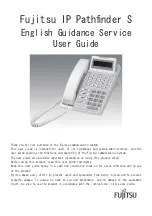
52
C
HAPTER
5: B
ASIC
T
ELEPHONE
O
PERATION
For example, suppose a company has three offices:
■
Phones at the Chicago office use an extension range from 1000
through 1999.
■
Phones at the Atlanta office use an extension range from 2000
through 2999.
■
Phones at the Dallas office use an extension range from 3000 through
3999.
In this example, to call a user in Dallas, a user in Chicago dials a Dallas
extension (3000 through 3999). The dial plan on the Chicago VCX system
sets up the necessary connection to the Dallas VCX system and then to
the extension at that site.
Using Site Codes
In some companies with geographically separated offices, phone
extensions may not be unique. If some users have overlapping telephone
extensions, your administrator can configure your telephone system to
require site codes that you must use to dial people at remote offices. Your
administrator chooses the site codes for your system. In this case, you dial
a site code first, followed by the extension at the site.
For example, suppose a company has three offices:
■
Phones at the Chicago office use an extension range from 1000
through 3999. The site code for Chicago is 61.
■
Phones at the Atlanta office use an extension range from 1000
through 3999. The site code for Atlanta is 62.
■
Phones at the Dallas office use an extension range from 1000 through
3999. The site code for Dallas is 63.
In this example, to call someone in Atlanta, a user in Chicago dials the
site code 62 and then the appropriate extension (1000 through 3999). To
reach a user in Dallas, a user in Chicago dials 63 and then the appropriate
extension (1000 through 3999). The site code prevents conflicts between
the remote extension number and a duplicated extension number at the
local site (Chicago).
Class of Service
Override
The Class of Service Override feature allows you to apply the capabilities
of your own VCX telephone
temporarily
to another VCX telephone on
the same local network.
















































